月日雅思阅读真题与解析
- 格式:doc
- 大小:25.00 KB
- 文档页数:3
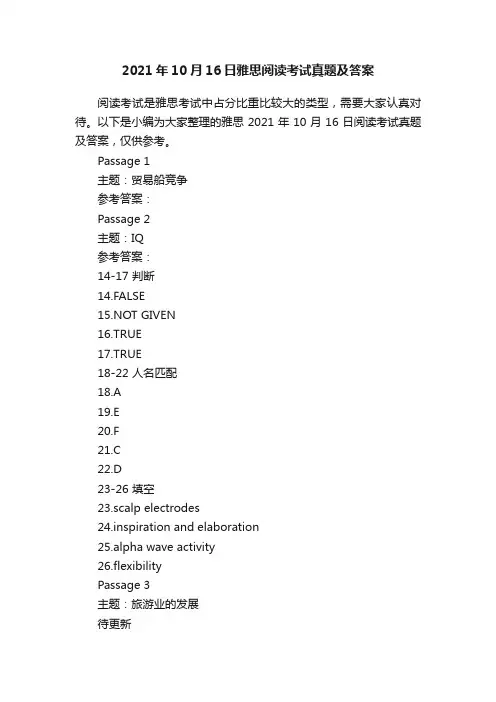
2021年10月16日雅思阅读考试真题及答案阅读考试是雅思考试中占分比重比较大的类型,需要大家认真对待。
以下是小编为大家整理的雅思2021年10月16日阅读考试真题及答案,仅供参考。
Passage 1主题:贸易船竞争参考答案:Passage 2主题:IQ参考答案:14-17 判断14.FALSE15.NOT GIVEN16.TRUE17.TRUE18-22 人名匹配18.A19.E20.F21.C22.D23-26 填空23.scalp electrodes24.inspiration and elaboration25.alpha wave activity26.flexibilityPassage 3主题:旅游业的发展待更新雅思9分对应阅读39-40分;雅思8.5分对阅读37-38分;雅思8.分对应阅读35-36分;雅思7.5分对应阅读33-34分;雅思7分对应阅读30-32分;雅思6.5分对应阅读27-29分;雅思6分对应阅读23-26分;雅思5.5分对应阅读20-22分;雅思5分对应阅读16-19分;雅思4.5分对应阅读13-15分;雅思4分对应阅读10-12分;雅思3.5分对应阅读6-9分;雅思3分对应阅读4-5分;雅思2.5分对应阅读3分;雅思2分对应阅读2分;雅思1分对应阅读1分。
选择题选择题其实是在考你对于原文中提及的一些详细信息的定位能力。
你需要快速读懂题目并选择出正确的选项。
往往除了正确选项以外还会有几个迷惑选项给你制造陷阱,你必须凭借原文中的特定信息来排除它们(或定位正确选项)。
Summary填空题这种题目一般是将原文的某一部分信息先进行了一个总结,然后设计了一些空让你填空。
你有可能需要用原文的单词进行填空,也可能需要用所给出的一些单词进行选词填空。
(词比空多)由于是对原文的总结,所以这段题干的内容在原文中肯定是出现的,但是绝对不会是原文重现,而是用一些同义词对原文的关键词进行替换。
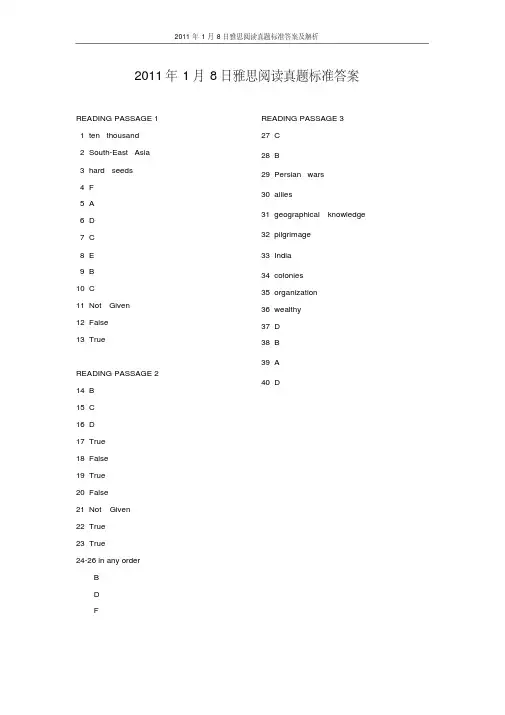
2011年1月8日雅思阅读真题标准答案 READING PASSAGE 11 ten thousand2 South-East Asia3 hard seeds4 F5 A6 D7 C8 E9 B10 C11 Not Given12 False13 TrueREADING PASSAGE 214 B15 C16 D17 True18 False19 True20 False21 Not Given22 True23 True24-26 in any orderBDF READING PASSAGE 327 C28 B29 Persian wars30 allies31 geographical knowledge32 pilgrimage33 India34 colonies35 organization36 wealthy37 D38 B39 A40 D2011年1月8日雅思阅读真题解析 READING PASSAGE 1Questions1‐31.题目答案一定为数字信息,同时根据顺序原则,答案应该出现在文章开头,于是定位于原文第一段第二句话“Agricultural scientists believe that the first edible banana was discovered around ten thousand years ago”,题目信息“eaten”对应原文中的“edible”,所以答案为ten thousand。
2.题目答案应该为一个地名,同时根据顺序原则,定位于第一段第三行中部“it was firstpropagated in the jungles of South‐East Asia…”,题目信息“planted”对应原文中的“propagated”,所以答案为South‐EastAsia。
taste”和顺序原则定位于第一段第四行“Normally the wild 3.利用细节信息“wild banana’sbanana…containsa mass of hard seeds that make the fruit virtually inedible”,题目信息“adversely affected”对应原文中的“virtually inedible”,所以答案为hard seeds或seeds。
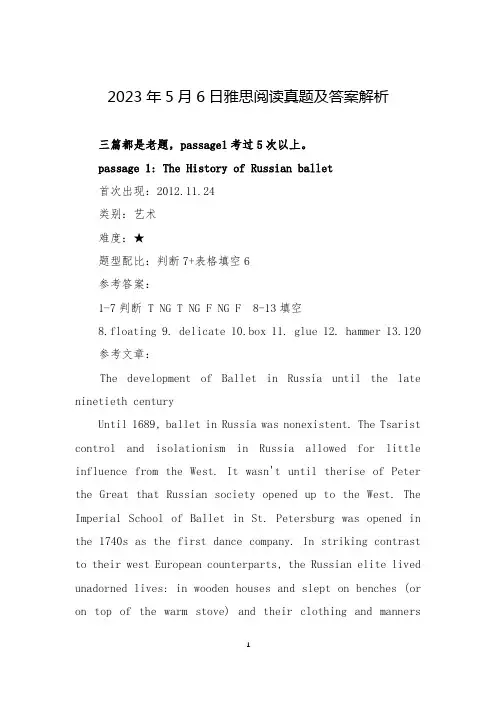
2023年5月6日雅思阅读真题及答案解析三篇都是老题,passage1考过5次以上。
passage 1: The History of Russian ballet首次出现:2012.11.24类别:艺术难度:★题型配比:判断7+表格填空6参考答案:1-7判断 T NG T NG F NG F 8-13填空8.floating 9. delicate 10.box 11. glue 12. hammer 13.120参考文章:The development of Ballet in Russia until the late ninetieth centuryUntil 1689, ballet in Russia was nonexistent. The Tsarist control and isolationism in Russia allowed for little influence from the West. It wasn't until therise of Peter the Great that Russian society opened up to the West. The Imperial School of Ballet in St. Petersburg was opened in the 1740s as the first dance company. In striking contrast to their west European counterparts, the Russian elite lived unadorned lives: in wooden houses and slept on benches (or on top of the warm stove) and their clothing and mannersresembled those of peasants: rough and indecorous.Peter the Great created a new Russia which rivaled the society of the West with magnificent courts and palaces. His vision was not to bring Russia to the West, but to bring the West to Russia. He created a court system like that in the West through legal edicts and strict rules. In the West art was an evidence of cultural freedom, but in Russiait was a deliberately controlled exp ression and advancement. “The rules were carefully laid out in The Honorable Mirror of Youth, a compilation of Western courtesy books designed to educate courtiers in the intricacies of refined behavior, including dancing.”Kirov Ballet Company was formed in 1738 in St. Petersburg by Jean Baptiste Landé and Empress Anna Ivanovna. It was originally called the Imperial Ballet and preformed for the mid-18th century courts. Landé acted as the director of this academy.Under the reign of Catherine, Le Picq was called theApollo of the dance and performed in many countries, such as France, Austria, Russia and Spain. Charles Le Picq was a huge influence on the development of Russian ballet. Thanks to him, the Noverre’ book Letters on the dance (fr: Lettres sur la danse) are published in Russia (in French) in 1803. He advised in 1801 to invite to Russia the Frenchchoreographer Charles Didelot.Charles-Louis Didelot arrived in Saint Petersburg in 1801 at the invitation of the director of the Imperial Theatres and he made his debut as the first dancer. He initiated the revival of patriotic literature in ballet. Another talented figure—Mikhail Glinka made musical compositions illustrate the unique composition “signature” of Russian people.Ballet academy was very strict in recruiting students. Talented Nijinsky was nearly ruled out for his flawed figure.Plots of some stories were changed to support the socialist realism although Ballet was introduced to Russia as an aristocratic dance by Peter the Great. Pushkin helped with this change.Marius Petipa spent fifty years staging ballets in Russia and was also the dominant figure in Russian ballet. He along with many other dancers brought new influences from Europe.Passage 2:超市监控首次出现:2013.07.27类别:商业难度:★★题型配比:段匹4+特殊词匹配6+句子填空3参考答案:14-17段匹 F E G C18-23特殊词匹配 E C E D A B24-26填空24.shopping units 25. children 26. competitors分析:p2在2013年首考,在2021年12月28日的考试中第二次出现,这是第三次考。
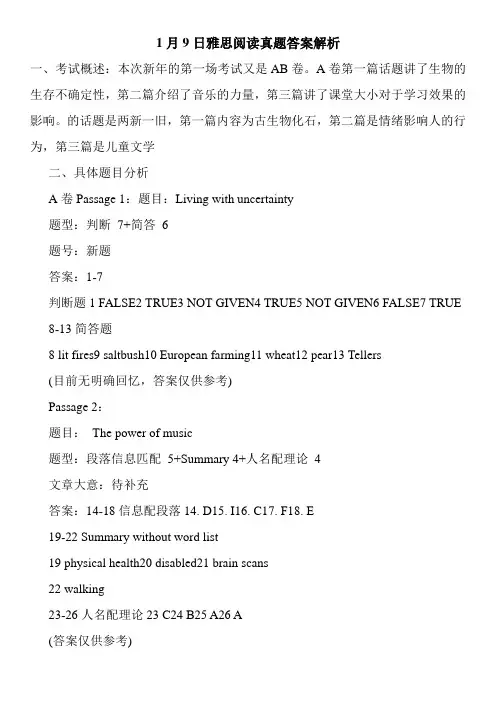
1月9日雅思阅读真题答案解析一、考试概述:本次新年的第一场考试又是AB卷。
A卷第一篇话题讲了生物的生存不确定性,第二篇介绍了音乐的力量,第三篇讲了课堂大小对于学习效果的影响。
的话题是两新一旧,第一篇内容为古生物化石,第二篇是情绪影响人的行为,第三篇是儿童文学二、具体题目分析A卷Passage 1:题目:Living with uncertainty题型:判断7+简答6题号:新题答案:1-7判断题1 FALSE2 TRUE3 NOT GIVEN4 TRUE5 NOT GIVEN6 FALSE7 TRUE 8-13简答题8 lit fires9 saltbush10 European farming11 wheat12 pear13 Tellers(目前无明确回忆,答案仅供参考)Passage 2:题目:The power of music题型:段落信息匹配5+Summary 4+人名配理论4文章大意:待补充答案:14-18信息配段落14. D15. I16. C17. F18. E19-22 Summary without word list19 physical health20 disabled21 brain scans22 walking23-26人名配理论23 C24 B25 A26 A(答案仅供参考)Passage 3:题名:Does class size matter?题型:段落信息匹配5+分类配对9文章大意:待补充答案:27-31段落信息匹配27 D28 E29 A30 C31 B32-40 Classification32 A33 C34 B35 C36 A37 C38 A39 B40 A(目前无明确回忆,答案仅供参考)B卷Passage 1:题目:The History of building telegraph lines题型:判断6+简答7文章大意:电报的发展史相似文章:A The idea of electrical communication seems to have begun as long ago as 1746, when about 200 monks at monastery in Paris arranged themselves in a line over a mile long, each holding ends of 25 ft iron wires. The abbot, also a scientist, discharged a primitive electrical battery into the wire, giving all the monks a simultaneous electrical shock. “This all sounds very silly, but is in fact extremely important because, firstly, they all said ‘ow’ which showed that you were sending a signal right along the line; and, secondly, they all said ‘ow’ at the same time, and that meant that you were sending the signal very quickly, “explains Tom Standage, author of the Victorian Internet and technology editor at the Economist. Given a more humane detection system, this could be a way of signaling over long distances.B With wars in Europe and colonies beyond, such a signalling system was urgently needed. All sorts of electrical possibilities were proposed, some of them quite ridiculous. Two Englishmen, William Cooke and Charles Wheatstone came up with a system in which dials were made to point at different letters, but that involved five wires and would have been expensive to construct.C Much simpler was that of an American, Samuel Morse, whose system only required a single wire to send a code of dots and dashes. At first, it was imagined that only a few highly skilled encoders would be able to use it but it soon became clear that many people could become proficient in Morse code. A system of lines strung on telegraph poles began to spread in Europe and America.D The next problem was to cross the sea. Britain, as an island with an empire, led the way. Any such cable had to be insulated and the first breakthrough came with the discovery that a rubber-like latex from a tropical tree on the Malay peninsula could do the trick. It was called gutta percha. The first attempt at a cross channel cable came in 1850. With thin wire and thick installation, it floated and had to be weighed down with lead pipe.E It never worked well as the effect of water on its electrical properties was not understood, and it is reputed that a French fishermen hooked out a section and took it home as a strange new form of seaweed The cable was too big for a single boat so two had to start in the middle of the Atlantic, join their cables and sail in opposite directions. Amazingly, they succeeded in 1858, and this enabled Queen Victoria to send a telegraph message to President Buchanan. However, the 98-word message took more than 19 hours to send and a misguided attempt to increase the speed by increasing the voltage resulted in failure of the line a week later.F By 1870, a submarine cable was heading towards Australia. It seemed likely that it would come ashore at the northern port of Darwin from where it might connect around the coast to Queensland and New South Wales. It was an undertaking more ambitious than spanning an ocean. Flocks of sheep had to be driven with the 400 workers to provide food. They needed horses and bullock carts and, for the parched interior, camels. In the north, tropical rains left the teams flooded. In the centre, it seemed that they would die of thirst. One critical section in the red heart of Australia involved finding a route through the McDonnell mountain range and then finding water on the other side.G The water was not only essential for the construction team. There had to be telegraph repeater stations every few hundred miles to boost the signal and the staff obviously had to have a supply of water, lust as one mapping team was about to give up and resort to drinking brackish water, some aboriginals took pity on them. Altogether, 40, 000telegraph poles were used in the Australian overland wire. Some were cut from trees. Where there were no trees, or where termites ate the wood, steel poles were imported.H On Thursday, August 22, 1872, the overland line was completed and the first messages could be sent across the continent; and within a few months, Australia was at last in direct contact with England via the submarine cable, too. The line remained in service to bring news of the Japanese attack on Darwin in 1942. it could cost several pounds to send a message and it might take several hours for it to reach its destination on the other side of the globe, but the world would never be same again. Governments could be in touch with their colonies. Traders could send cargoes based on demand and the latest prices. Newspapers could publish news that had just happened and was notmany months old.答案:Questions 1-61 In the research of French scientists, the metal lines were used to send message T2 Abbots gave the monks an electrical shock at the same time, which constitutes the exploration on the long-distance signaling. T3 Using Morse Code to send message need to simplify the message firstly F4 Morse was a famous inventor before he invented the code T5 The water is significant to early telegraph repeater on continent. T6 US Government offered fund to the I st overland line across the continent NGQuestions 7-14Answer the questions below.Choose NO MORE THAN TWO WORDS AND / OR A NUMBER from the passage for each answer.Write your answers in boxes 7-14 on your answer sheet.7. Why is the disadvantage for the Charles Wheatstone’s telegraph system to fail in the beginning?It’s expensive8. What material was used for insulating cable across the sea?latex9. What was used by British pioneers to increase the weight of the cable in the sea?Lead ripe10. What did Fisherman mistakenly take the cable as?Unusual seaseed11. Who was the message firstly sent to across the Atlantic by the Queen?President Buchanan12. What giant animals were used to carry the cable through desert?camels13. What weather condition did it delay the construction in northAustralia?Tropical rain14. How long did it take to send a telegraph message from Australia to England?Several hours(答案仅供参考)Passage 2:题目:儿童天赋和能力影响题型:判断5+概括5+多项选择4文章大意:孩子的天赋和能力影响,孩子容易受到环境影响学习到一些能力,而大人不容易,各种比较,举了语言的例子和其他能力的例子答案:1-4选择题1. Which one not mentioned about infantA intelligence C social skills D language2. What the animal experiment is to illustrate Different lines and angles affect sight3. the second experiment on … is prove that Human’s development is similar to animals in this area4. Why children appears mindlessCortex still does work5-9 summary实验用的speech sound语言是Japanese研究人员选用的,做第二个实验给小孩听噪音(noise)心跳变快(heart rate),第三个实验visual observation有关,仔细观察physical eye movement.第四个实验因为选的地域广,结论充分harness dialects,由此科学家可以很好的控制他们的实验。
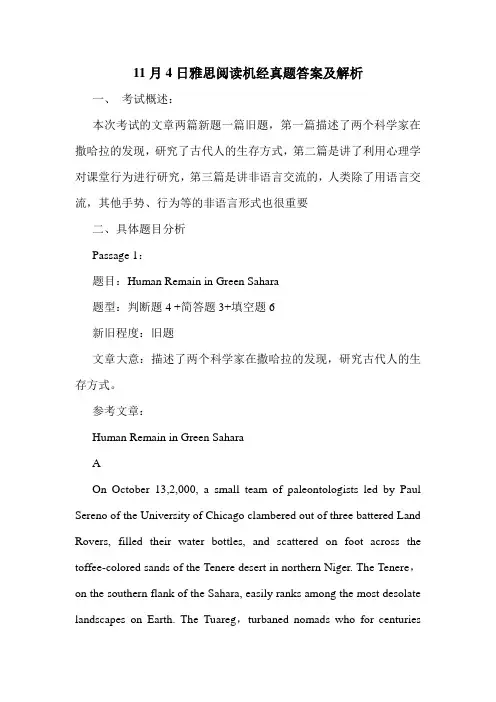
11月4日雅思阅读机经真题答案及解析一、考试概述:本次考试的文章两篇新题一篇旧题,第一篇描述了两个科学家在撒哈拉的发现,研究了古代人的生存方式,第二篇是讲了利用心理学对课堂行为进行研究,第三篇是讲非语言交流的,人类除了用语言交流,其他手势、行为等的非语言形式也很重要二、具体题目分析Passage 1:题目:Human Remain in Green Sahara题型:判断题4 +简答题3+填空题6新旧程度:旧题文章大意:描述了两个科学家在撒哈拉的发现,研究古代人的生存方式。
参考文章:Human Remain in Green SaharaAOn October 13,2,000, a small team of paleontologists led by Paul Sereno of the University of Chicago clambered out of three battered Land Rovers, filled their water bottles, and scattered on foot across the toffee-colored sands of the Tenere desert in northern Niger. The Tenere,on the southern flank of the Sahara, easily ranks among the most desolate landscapes on Earth. The Tuareg,turbaned nomads who for centurieshave ruled this barren realm, refer to it as a “desert within a desert”a California-size ocean of sand and rock, where a single massive dune might stretch a hundred miles, and the combination of 120-degreeheat and inexorable winds can wick the water from a human body in less than a day. The harsh conditions, combined with intermittent conflict between the Tuareg and the Niger government, have kept the region largely unexplored.BMike Hettwer, a photographer accompanying the team, headed off by himself toward a trio of small dunes. He crested the first slope and stared in amazement. The dunes were spilling over with bones. He took a few shots with his digital camera and hurried back to the Land Rovers. ‘I found some bones:’Hettwer said, when the team had regrouped. “But they’re not dinosaurs. They’re human.”CIn the spring of 2005 Sereno contacted Elena Garcea, an archaeologist at the University of Cassino, in Italy, inviting her to accompany him on a return to the site. Garcea had spent three decades working digs along the Nile in Sudan and in the mountains of the Libyan Desert, and was well acquainted with the ancient peoples of the Sahara. But she had never heard of Paul Sereno. His claim to have found so many skeletons in one place seemed far fetched, given that no other Neolithic cemeterycontained more than a dozen or so. Some archaeologists would later be skeptical; one sniped that he was just a ‘moonlighting paleontologist.’But Garcea was too intrigued to dismiss him as an interloper. She agreed to join him.DGarcea explained that the Kiffian were a fishing-based culture and lived during the earliest wet period, between 8,000 and 10,000 years ago. She held a Kiffian sherd next to a Tenerian one. “What is so amazing is that the people who made these two pots lived more than a thousand years apart.EOver the next three weeks, Sereno and Garcea-- along with five American excavators, five Tuareg guides, and five soldiers from Niger’s army, sent to protect the camp from bandits-- made a detailed map of the site, which they dubbed Gobero, after the Tuareg name for the area. They exhumed eight burials and collected scores of artifacts from both cultures. In a dry lake bed adjacent to the dunes, they found dozens of fishhooks and harpoons carved from animal bone. Apparently the Kiffian fishermen weren’t just going after small fry: Scattered near the dunes were the remains of Nile perch, a beast of a fish that can weigh nearly 300 pounds, as well as crocodile and hippo bones.FSereno flew home with the most important skeletons and artifacts and immediately began planning for the next field season. In the meantime, he carefully removed one tooth from each of four skulls and sent them to a lab for radiocarbon dating. The results pegged the age of the tightly bundled burial sat roughly 9,000 years old, the heart of the Kiffian era. The smaller ‘sleeping’skeletons turned out to be about 6,000 years old, well within the Tenerian period. At least now the scientists knew who was who.G In the fall of 2006 they returned to Gobero, accompanied by a larger dig crew and six additional scientists. Garcea hoped to excavate some80 burials, and the team began digging. As the skeletons began to emerge from the dunes, each presented a fresh riddle, especially the Tenerian. A male skeleton had been buried with a finger in his mouth.HEven at the site, Arizona State University bioarchaeologist Chris Stojanowski could begin to piece together some clues. Judging by the bones, the Kiffian appeared t o be a peaceful, hardworking people. “The lack of head and forearm injuries suggests they weren’t doing much fighting,” he told me. “And these guys were strong.” He pointed to a long,narrow ridge running along a femur. “That’s the muscle attachment,” he said. “This individual had huge leg muscles, which means he was eating a lot of protein and had a strenuous lifestyle-- bothconsistent with a fishing way of life.” For contrast, he showed me the femur of a Tenerian male. The ridge was barely perceptible. “T his guy had a much less strenuous lifestyle,” he said, “which you might expect of a herder.”IStojanowski’s assessment that the Tenerian were herders fits the prevailing view among scholars of life in the Sahara 6,000 years ago, when drier conditions favored herding over hunting. But if the Tenerian were herders, Sereno pointed out, where were the herds? Among the hundreds of animal bones that had turned up at the site, none belonged to goats or sheep, and only three came from a cow species. “It’s not unusual for a herding culture not to slaughter their cattle, particularly in a cemetery,M Garcea responded, noting that even modem pastoralists, such as Niger’s Wodaabe, are loath to butcher even one animal in their herd. Perhaps, Sereno reasoned, the Tenerian at Gobero were a transitional group that had not fully adopted herding and still relied heavily on hunting and fishing.JBack in Arizona, Stojanowski continues to analyze the Gobero bones for clues to the Green Saharans’health and diet. Other scientists are trying to derive DNA from the teeth, which could reveal the genetic origins of the Kiffian and Tenerian —and possibly link them todescendants living today. Sereno and Garcea estimate a hundred burials remain to be excavated. But as the harsh Tenere winds continue to erode the dunes, time is running out. “Every archaeological site has a life cycle,” Garcea said. “It begins when people begin to use the place, followed by disuse, then nature takes over, and finally it is gone. Gobero is at the end of its life.”。
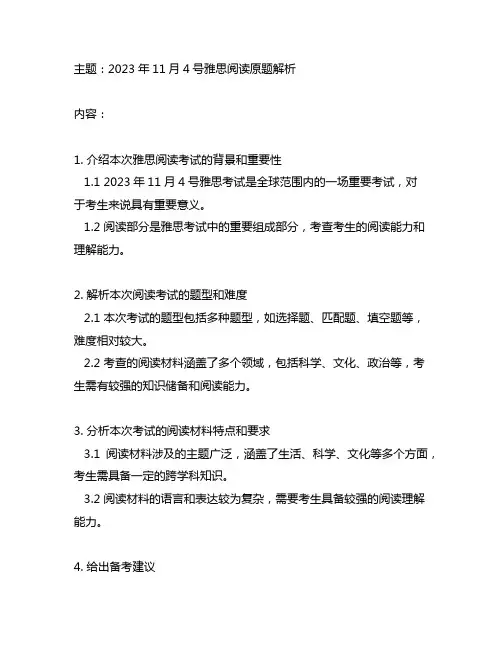
主题:2023年11月4号雅思阅读原题解析内容:1. 介绍本次雅思阅读考试的背景和重要性1.1 2023年11月4号雅思考试是全球范围内的一场重要考试,对于考生来说具有重要意义。
1.2 阅读部分是雅思考试中的重要组成部分,考查考生的阅读能力和理解能力。
2. 解析本次阅读考试的题型和难度2.1 本次考试的题型包括多种题型,如选择题、匹配题、填空题等,难度相对较大。
2.2 考查的阅读材料涵盖了多个领域,包括科学、文化、政治等,考生需有较强的知识储备和阅读能力。
3. 分析本次考试的阅读材料特点和要求3.1 阅读材料涉及的主题广泛,涵盖了生活、科学、文化等多个方面,考生需具备一定的跨学科知识。
3.2 阅读材料的语言和表达较为复杂,需要考生具备较强的阅读理解能力。
4. 给出备考建议4.1 建议考生在备考阶段注重积累词汇和阅读材料,提高阅读理解能力。
4.2 建议考生在平时多阅读英文报刊、杂志等,提高阅读速度和理解能力。
4.3 建议考生注重平时的练习,熟悉不同题型的解题技巧,提高应试能力。
5. 总结本次考试的重点和难点5.1 本次考试的重点在于考查考生的跨学科知识储备和阅读理解能力。
5.2 本次考试的难点在于阅读材料的复杂性和题型的多样性,需要考生具备较高的应试能力。
通过以上分析和解析,我们可以看出2023年11月4号雅思阅读考试的重要性以及考试的题型、难度和要求。
希望考生在备考过程中能够充分认识到考试的重要性,有针对性地进行备考,提高自己的阅读能力和应试能力,取得优异的成绩。
2023年11月4号雅思阅读考试的重要性不言而喻,对于很多留学和移民澳洲、加拿大等国家的考生来说,雅思成绩是他们申请学校或签证的必备条件。
而阅读部分作为整个考试的重要组成部分,对考生的阅读能力和理解能力有着很高的要求,因此备考阅读部分显得至关重要。
本次考试的题型多样,包括选择题、匹配题、填空题等。
这就要求考生不仅要具备良好的词汇量和阅读理解能力,还需要熟悉不同题型的解题技巧,这样才能更好地应对考试。
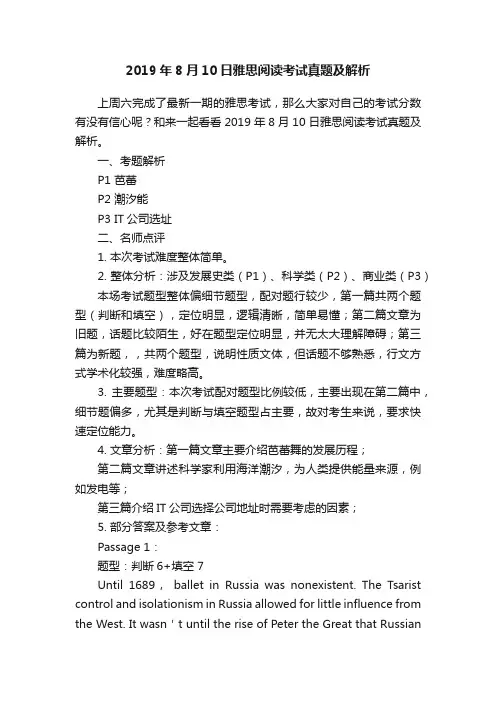
2019年8月10日雅思阅读考试真题及解析上周六完成了最新一期的雅思考试,那么大家对自己的考试分数有没有信心呢?和来一起看看2019年8月10日雅思阅读考试真题及解析。
一、考题解析P1 芭蕾P2 潮汐能P3 IT公司选址二、名师点评1. 本次考试难度整体简单。
2. 整体分析:涉及发展史类(P1)、科学类(P2)、商业类(P3)本场考试题型整体偏细节题型,配对题行较少,第一篇共两个题型(判断和填空),定位明显,逻辑清晰,简单易懂;第二篇文章为旧题,话题比较陌生,好在题型定位明显,并无太大理解障碍;第三篇为新题,,共两个题型,说明性质文体,但话题不够熟悉,行文方式学术化较强,难度略高。
3. 主要题型:本次考试配对题型比例较低,主要出现在第二篇中,细节题偏多,尤其是判断与填空题型占主要,故对考生来说,要求快速定位能力。
4. 文章分析:第一篇文章主要介绍芭蕾舞的发展历程;第二篇文章讲述科学家利用海洋潮汐,为人类提供能量来源,例如发电等;第三篇介绍IT公司选择公司地址时需要考虑的因素;5. 部分答案及参考文章:Passage 1:题型:判断6+填空 7Until 1689,ballet in Russia was nonexistent. The Tsarist control and isolationism in Russia allowed for little influence from the West. It wasn't until the rise of Peter the Great that Russiansociety opened up to the West. St. Petersburg was erected to embrace the West and compete against Moscow’s isolationism. Peter the Great created a new Russia which rivaled the society of the West with magnificent courts and palaces. His vision was to challenge the west. Classical ballet entered the realm of Russia not as entertainment,but as a “standard of physical comportment to be emulated and internalized-an idealized way of behaving. The aim was not to entertain the masses of Russians,but to create a cultivated and new Russian people.Empress Anna,(1730 –1740)was devoted to ostentatious amusements (balls, fireworks, tableaux), and in the summer of 1734 ordered the appointment of Jean-Baptiste Landé as dancing-master in the military academy she had founded in 1731 for sons of the nobility. In 1738, he became ballet master and head of the new ballet school, launching the advanced study of ballet in Russia, and winning the patronage of elite families.France provided many leaders such as Charles Didelot in St Petersburg (1801-1831),Jules Perrot(1848-1859)and Arthur Saint-Léon (1859-69).In the early 19th century, the theaters were opened up to anyone who could afford a ticket. A seating section called a rayok,or 'paradise gallery', consisted of simple wooden benches. This allowed non-wealthy people access to the ballet, because tickets in this section were inexpensive.One author describes the Imperial ballet as “unlike that of any other country in the world…the most prestigious of the ballet troupes were those attached to the state-supported theatres. The directors of these companies were personally appointed by the tsar, and all the dancers were, in a sense, Imperial servants.In the theatre,the men in the audience always remained standing until the tsar entered his box and,out of respect,after the performance they remained in their places until he had departed. Curtain calls were arranged according to a strict pattern: first,the ballerina bowed to the tsar’s box, then to that of the theater director, and finally to the general public1. T2. F3. NG4. T5. T6. F7. theater8. win worldwide popularity9. dance and dress10. ?11. successful publication12. director13. comic技巧分析:本文并未出现配对题型,考生应尽可能利用定位法找出答案,细节题型同时出现,考生可以根据顺序原则快速定位答案范围,同时留意三个题型间的关系,如处在中间的判断题,可以根据单选的最后一题出现的位置向后找,可以提高效率;做选择题时需要注意巧妙利用排除法,找出最合适的答案;最后需要注意多选题答案一般涉及文章一部分,根据其出现的位置,可以从文章结尾向前找答案,节省时间。
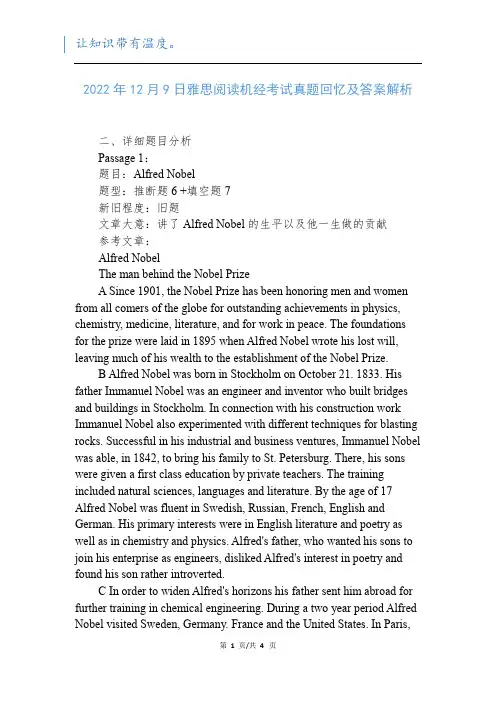
2022年12月9日雅思阅读机经考试真题回忆及答案解析二、详细题目分析Passage 1:题目:Alfred Nobel题型:推断题6 +填空题7新旧程度:旧题文章大意:讲了Alfred Nobel的生平以及他一生做的贡献参考文章:Alfred NobelThe man behind the Nobel PrizeA Since 1901, the Nobel Prize has been honoring men and women from all comers of the globe for outstanding achievements in physics, chemistry, medicine, literature, and for work in peace. The foundations for the prize were laid in 1895 when Alfred Nobel wrote his lost will, leaving much of his wealth to the establishment of the Nobel Prize.B Alfred Nobel was born in Stockholm on October 21. 1833. His father Immanuel Nobel was an engineer and inventor who built bridges and buildings in Stockholm. In connection with his construction work Immanuel Nobel also experimented with different techniques for blasting rocks. Successful in his industrial and business ventures, Immanuel Nobel was able, in 1842, to bring his family to St. Petersburg. There, his sons were given a first class education by private teachers. The training included natural sciences, languages and literature. By the age of 17 Alfred Nobel was fluent in Swedish, Russian, French, English and German. His primary interests were in English literature and poetry as well as in chemistry and physics. Alfred's father, who wanted his sons to join his enterprise as engineers, disliked Alfred's interest in poetry and found his son rather introverted.C In order to widen Alfred's horizons his father sent him abroad for further training in chemical engineering. During a two year period Alfred Nobel visited Sweden, Germany. France and the United States. In Paris,the city he came to like best, he worked in the private laboratory of Professor T. J. Pelouze, a famous chemist. There he met the young Italian chemist Ascanio Sobrero who, three years earlier, had invented nitroglycerine, a highly explosive liquid. But it was considered too dangerous to be of any practical use. Although its explosive power greatly exceeded that of gunpowder, the liquid would explode in a very unpredictable manner if subjected to heat and pressure. Alfred Nobel became very interested in nitroglycerine and how it could be put to practical use in construction work. He also realized that the safety problems had to be solved and a method had to be developed for the controlled detonation of nitroglycerine.D After his return to Sweden in 1863, Alfred Nobel concentrated on developing nitroglycerine as an explosive. Several explosions, including one (1864) in which his brother Kmil and several other persons were killed, convinced the authorities that nitroglycerine production was exceedingly dangerous. They forbade further experimentation with nitroglycerine within the Stockholm city limits and Alfred Nobel had to move his experimentation to a barge anchored on Lake Malaren. Alfred was not discouraged and in 1864 he was able to start mass production of nitroglycerine. To make the handling of nitroglycerine safer Alfred Nobel experimented with different additives. He soon found that mixing nitroglycerine with kieselguhr would turn the liquid into a paste which could be shaped into rods of a size and form suitable for insertion into drilling holes. In 1867 he patented this material under die name of dynamite. To be able to detonate the dynamite rods he also invented a detonator (blasting cap) which could be ignited by lighting a fuse. These inventions were made at the same time as the pneumatic drill came into general use. Together these inventions drastically reduced the cost of blasting rock, drilling tunnels, building canals and many other forms of construction work.E The market for dynamite and detonating caps grew very rapidly and Alfred Nobel also proved himself to be a very skillful entrepreneur and businessman. Over the years he founded factories and laboratories in some 90 different places in more than 20 countries. Although he lived inParis much of his life he was constantly traveling. When he was not traveling or engaging in business activities Nobel himself worked intensively in his various laboratories, first in Stockholm and later in other places. He focused on the development of explosives technology as well as other chemical inventions, including such materials as synthetic rubber and leather, artificial silk, etc. By the time of his death in 18% he had 355 patents.F Intensive work and travel did not leave much time for a private life. At the age of 43 he was feeling like an old man. At this time he advertised in a newspaper “Wealthy, highly-educated elder gentleman seeks lady of mature age, versed in languages, as secretary and supervisor of household. The most qualified applicant turned out to be an Austrian woman. Countess Bertha Kinsky. After working a very short time for Nobel she decided to return to Austria to marry Count Arthur von Suttner. In spite of this Alfred Nobel and Bertha von Suttner remained friends and kept writing letters to each other for decades. Over the years Bertha von Suttner became increasingly critical of the arms race. She wrote a famous book, Lay Down Your Arms and became a prominent figure in the peace movement. No doubt this influenced Alfred Nobel when he wrote his final will which was to include a Prize for persons or organizations who promote peace. Several years after the death of Alfred Nobel, the Norwegian Storting (Parliament) decided to award the 1905 Nobel Peace Prize to Bertha von Suttner.G Alfred Nobel died in San Remo, Italy, on December 10, 1896. When his will was opened it came as a surprise that his fortune was to be used for Prizes in Physics, Chemistry. Physiology or Medicine, Literature and Peace. The executors of his will were two young engineers, Ragnar Sohlman and Rudolf Lilljequist. They set about forming the Nobel Foundation as an organization to take care of the financial assets left by Nobel for this purpose and to coordinate the work of the Prize-Awarding Institutions. This was not without its difficulties since the will was contested by relatives and questioned by authorities in various countries.H Alfred Nobel's greatness lay in his ability to combine the penetrating mind of the scientist and inventor with the forward-lookingdynamism of the industrialist. Nobel was very interested in social and peace-related issues and held what were considered radical views in his era. He had a great interest in literature and wrote his own poetry and dramatic works. The Nobel Prizes became an extension d a fulfillment of his lifetime interests.参考答案:推断题:1. The first Nobel Prize was awarded in 1895. FALSE2. Nobel's father wanted his son to have better education than what he had had. NOT GIVEN3. Nobel was an unsuccessful businessman. FALSE4. Bertha von Suttner was selected by Nobel himself for the first peace prize. FALSE5. The Nobel Foundation was established after the death of Nobel. TRUE6. Nobel's social involvement was uncommon in the 1800’s. TRUE填空题:7. chemical engineering8. Ascanio Sobrero9. gunpowder10. Stockholm11. detonator12. pneumatic drill13. cost(答案仅供参考)文档内容到此结束,欢迎大家下载、修改、丰富并分享给更多有需要的人。
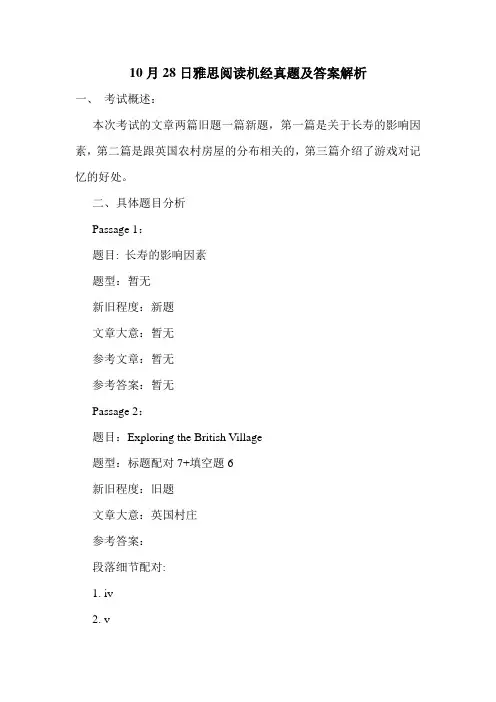
10月28日雅思阅读机经真题及答案解析一、考试概述:本次考试的文章两篇旧题一篇新题,第一篇是关于长寿的影响因素,第二篇是跟英国农村房屋的分布相关的,第三篇介绍了游戏对记忆的好处。
二、具体题目分析Passage 1:题目: 长寿的影响因素题型:暂无新旧程度:新题文章大意:暂无参考文章:暂无参考答案:暂无Passage 2:题目:Exploring the British Village题型:标题配对7+填空题6新旧程度:旧题文章大意:英国村庄参考答案:段落细节配对:1. iv2. v3. i4. vii5. viii6. ix7. ii填空题:8. cottage9. Domesday Book10. self sufficient11. remnants12. defense13. triangular(答案仅供参考)Passage 3:题目: Video-games’Unexpected Benefits to Human Brain(游戏的好处)题型:单选题4 +判断题4+人名配对5新旧程度:旧题文章大意:讲网游会对大脑产生哪些好处,比如会让孩子聪明,教授孩子高级思维方式,真正锻炼大脑,能让孩子思考如何更好的分配资源,如何合作等等。
参考文章:Video Games’Unexpected Benefits to Human BrainAJames Paul Gee, professor of education at the University of Wisconsin Madison, played his first video game years ago when his six-year-old son Sam was playing Pajama Sam: No Need to Hide When It’s Dark Outside. He wanted to play the game so he could support Sam’s problem solving. Though Pajama Sam is not an “educational game”, it is replete with the types of problems psychologists study when they study thinking and learning. When he saw how well the game held Sam’s attention, he wondered what sort of beast a more mature video game might be.BVideo and computer games, like many other popular, entertaining and addicting kid’s activities, are looked down upon by many parents as time wasters, and worse, parents think that these games rot the brain. Violent video games are readily blamed by the media and some experts as the reason why some youth become violent or commit extreme anti-social behavior. Recent content analyses of video games show that as many as 89% of games contain some violent content, but there is no form of aggressive content for 70% of popular games. Many scientists and psychologists, like James Paul Gee, find that video games actually have many benefits - the main one being making kids smart. Video games mayactually teach kids high-level thinking skills that they will need in the future.C“Video games change your brain,” according to University of Wisconsin psychologist Shawn Green. Video games change the brain’s physical structure the same way as do learning to read, playing the piano, or navigating using a map. Much like exercise can build muscle, the powerful combination of concentration and rewarding surges of neurotransmitters like dopamine, which strengthens neural circuits, can build the player’s brain.DVideo games give your child’s brain a real workout. In many video games, the skills required to win involve abstract and high level thinking. These skills are not even taught at school. Some of the mental skills trained by video games include: following instructions, problem solving, logic, hand-eye coordination, fine motor and spatial skills. Research also suggests that people can learn iconic, spatial, and visual attention skills from video games. There have been even studies with adults showing that experience with video games is related to better surgical skills. Jacob Benjamin, doctor from Beth Israel Medical Center NY, found a direct link between skill at video gaming and skill at keyhole or laparoscopic surgery. Also, a reason given by experts as to why fighter pilots of today are moreskillful is that this generation’s pilots are being weaned on video games.EThe players learn to manage resources that are limited, and decide the best use of resources, the same way as in real life. In strategy games, for instance, while developing a city, an unexpected surprise like an enemy might emerge. This forces the player to be flexible and quickly change tactics. Sometimes the player does this almost every second of the game giving the brain a real workout. According to researchers at the University of Rochester, led by Daphne Bavelier, a cognitive scientist, games simulating stressful events such as those found in battle or action games could be a training tool for real world situations. The study suggests that playing action video games primes the brain to make quick decisions. Video games can be used to train soldiers and surgeons, according to the study. Steven Johnson, author of Everything Bad is Good For You: How Today’s Popular Culture, says gamers must deal with immediate problems while keeping their long-term goals on their horizon. Young gamers force themselves to read to get instructions, follow storylines of games, and get information from the game texts.。
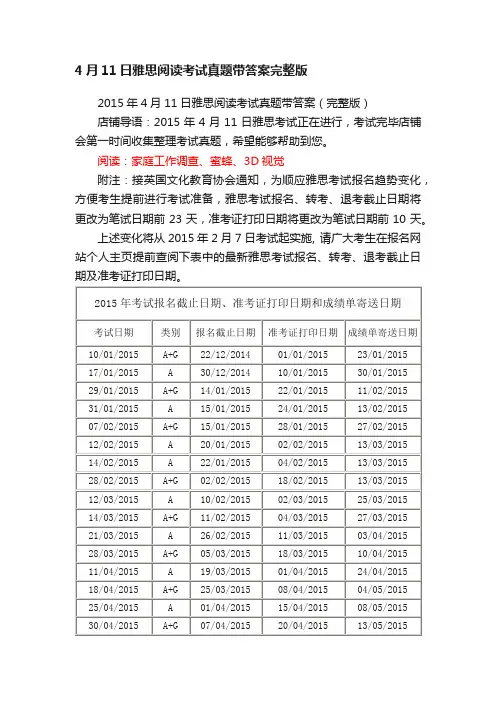
4月11日雅思阅读考试真题带答案完整版
2015年4月11日雅思阅读考试真题带答案(完整版)
店铺导语:2015年4月11日雅思考试正在进行,考试完毕店铺会第一时间收集整理考试真题,希望能够帮助到您。
阅读:家庭工作调查、蜜蜂、3D视觉
附注:接英国文化教育协会通知,为顺应雅思考试报名趋势变化,方便考生提前进行考试准备,雅思考试报名、转考、退考截止日期将更改为笔试日期前23天,准考证打印日期将更改为笔试日期前10天。
上述变化将从2015年2月7日考试起实施, 请广大考生在报名网站个人主页提前查阅下表中的最新雅思考试报名、转考、退考截止日期及准考证打印日期。
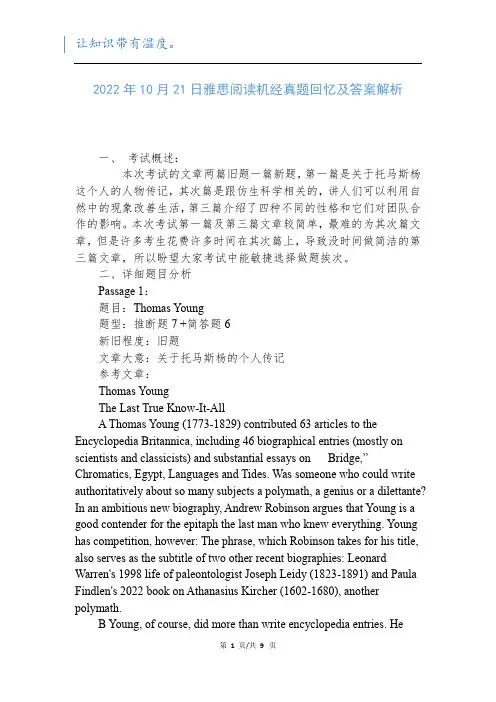
2022年10月21日雅思阅读机经真题回忆及答案解析一、考试概述:本次考试的文章两篇旧题一篇新题,第一篇是关于托马斯杨这个人的人物传记,其次篇是跟仿生科学相关的,讲人们可以利用自然中的现象改善生活,第三篇介绍了四种不同的性格和它们对团队合作的影响。
本次考试第一篇及第三篇文章较简单,最难的为其次篇文章,但是许多考生花费许多时间在其次篇上,导致没时间做简洁的第三篇文章,所以盼望大家考试中能敏捷选择做题挨次。
二、详细题目分析Passage 1:题目:Thomas Young题型:推断题7 +简答题6新旧程度:旧题文章大意:关于托马斯杨的个人传记参考文章:Thomas YoungThe Last True Know-It-AllA Thomas Young (1773-1829) contributed 63 articles to the Encyclopedia Britannica, including 46 biographical entries (mostly on scientists and classicists) and substantial essays on Bridge,” Chromatics, Egypt, Languages and Tides. Was someone who could write authoritatively about so many subjects a polymath, a genius or a dilettante? In an ambitious new biography, Andrew Robinson argues that Young is a good contender for the epitaph the last man who knew everything. Young has competition, however: The phrase, which Robinson takes for his title, also serves as the subtitle of two other recent biographies: Leonard Warren's 1998 life of paleontologist Joseph Leidy (1823-1891) and Paula Findlen's 2022 book on Athanasius Kircher (1602-1680), another polymath.B Young, of course, did more than write encyclopedia entries. Hepresented his first paper to the Royal Society of London at the age of 20 and was elected a Fellow a week after his 21st birthday. In the paper, Young explained the process of accommodation in the human eye on how the eye focuses properly on objects at varying distances. Young hypothesized that this was achieved by changes in the shape of the lens. Young also theorized that light traveled in waves and he believed that, to account for the ability to see in color, there must be three receptors in the eye corresponding to the three principal colors to which the retina could respond: red, green, violet. All these hypothesis were subsequently proved to be correct.C Later in his life, when he was in his forties, Young was instrumental in cracking the code that unlocked the unknown script on the Rosetta Stone, a tablet that was found in Egypt by the Napoleonic army in 1799. The stone contains text in three alphabets: Greek, something unrecognizable and Egyptian hieroglyphs. The unrecognizable script is now known as demotic and, as Young deduced, is related directly to hieroglyphic. His initial work on this appeared in his Britannica entry on Egypt. In another entry, he coined the term Indo-European to describe the family of languages spoken throughout most of Europe and northern India. These are the landmark achievements of a man who was a child prodigy and who, unlike many remarkable children, did not disappear into oblivion as an adult.D Born in 1773 in Somerset in England, Young lived from an early age with his maternal grandfather, eventually leaving to attend boarding school. He had devoured books from the age of two, and through his own initiative he excelled at Latin, Greek, mathematics and natural philosophy. After leaving school, he was greatly encouraged by his mother's uncle, Richard Brocklesby, a physician and Fellow of the Royal Society. Following Brocklesby's lead, Young decided to pursue a career in medicine. He studied in London, following the medical circuit, and then moved on to more formal education in Edinburgh, Gottingen and Cambridge. After completing his medical training at the University of Cambridge in 1808, Young set up practice as a physician in London. He soon became a Fellow of the Royal College of Physicians and a few yearslater was appointed physician at St. George's Hospital.E Young's skill as a physician, however, did not equal his skill as a scholar of natural philosophy or linguistics. Earlier, in 1801, he had been appointed to a professorship of natural philosophy at the Royal Institution, where he delivered as many as 60 lectures in a year. These were published in two volumes in 1807. In 1804 Young had become secretary to the Royal Society, a post he would hold until his death. His opinions were sought on civic and national matters, such as the introduction of gas lighting to London and methods of ship construction. From 1819 he was superintendent of the Nautical Almanac and secretary to the Board of Longitude. From 1824 to 1829 he was physician to and inspector of calculations for the Palladian Insurance Company. Between 1816 and 1825 he contributed his many and various entries to the Encyclopedia Britannica, and throughout his career he authored numerous books, essays and papers.F Young is a perfect subject for a biography - perfect, but daunting. Few men contributed so much to so many technical fields. Robinson's aim is to introduce non-scientists to Young's work and life. He succeeds, providing clear expositions of the technical material (especially that on optics and Egyptian hieroglyphs). Some readers of this book will, like Robinson, find Young's accomplishments impressive; others will see him as some historians have - as a dilettante. Yet despite the rich material presented in this book, readers will not end up knowing Young personally. We catch glimpses of a playful Young, doodling Greek and Latin phrases in his notes on medical lectures and translating the verses that a young lady had written on the walls of a summerhouse into Greek elegiacs. Young was introduced into elite society, attended the theatre and learned to dance and play the flute. In addition, he was an accomplished horseman. However, his personal life looks pale next to his vibrant career and studies.G Young married Eliza Maxwell in 1804, and according to Robinson, their marriage was a happy one and she appreciated his work. Almost all we know about her is that she sustained her husband through some rancorous disputes about optics and that she worried about money whenhis medical career was slow to take off. Very little evidence survives about the complexities of Young's relationships with his mother and father. Robinson does not credit them, or anyone else, with shaping Young's extraordinary mind. Despite the lack of details concerning Young's relationships, however, anyone interested in what it means to be a genius should read this book.参考答案:推断题:1.“The last man who knew everything” has also been claimed to other people. TURE2. All Young’s articles were published in Encyclopedia Britannica. FALSE3. Like others, Young wasn't so brilliant when grew up. FALSE4. Young's talents as a doctor are surpassing his other skills. NOT GIVEN5. Young's advice was sought by people responsible for local and national issues. TRUE6. Young was interested in various social pastimes. TRUE7. Young suffered from a disease in his later years. NOT GIVEN填空题:8. How many life stories did Young write for Encyclopedia Britannica? 469. What aspect of scientific research did Young do in his first academic paper? human eye10. What name did Young introduce to refer to a group of languages? Indo-European11. Who inspired Young to start the medical studies? Richard Brocklesby12. Where did Young get a teaching position? Royal Institution13. What contribution did Young make to London? gas lighting(答案仅供参考)Passage 2:题目: Learn the nature题型:段落细节配对4+填空题5+人名理论配对4新旧程度:新题文章大意:讲仿生科学的,写出大自然里有许多现象可以被学习和利用,用于科学讨论改善人类社会和生活。
2019年8月1日雅思阅读考试真题及解析八月的第一场雅思考试已经顺利地落下了帷幕,可以说是有人欢喜有人愁。
今天就跟着店铺来一起看看2019年8月1日雅思阅读考试真题及解析。
Passage1:非洲某个国家的农业参考原文及答案:A By tradition land in Luapula is not owned by individuals,but as in many other parts of Africa is allocated by the headman or headwoman of a village to people of either sex, according to need. Since land is generally prepared by hand,one ulupwa cannot take on a very large area; in this sense land has not been a limiting resource over large parts of the province. The situation has already changed near the main townships, and there has long been a scarcity of land for cultivation in the Valley. In these areas registered ownership patterns are becoming prevalent.B Most of the traditional cropping in Luapula,as in the Bemba area to the east,is based on citemene,a system whereby crops are grown on the ashes of tree branches. As a rule,entire trees are not felled (v. 砍到),but are pollarded (v. 截去树梢)so that they can regenerate. Branches are cut over an area of varying size early in the dry season, and stacked to dry over a rough circle about a fifth to a tenth of the pollarded area. The wood is fired before the rains and in the first year planted with the African cereal finger millet (Eleusine coracana). The grain of this crop is used to brew local beers such as cipumu, which contribute several vitamins of the B complex to peoples’ diet. Cipumu is also used in cementing reciprocal working relationships (Pottier 1985).C During the second season, and possibly for a few seasonsmore the area is planted to variously mixed combinations of annuals (n. 一年生植物)such as maize,pumpkins (Telfiria occidentalis)and other cucurbits,sweet potatoes,groundnuts,Phaseolus beans and various leafy vegetables,grown with a certain amount of rotation (n. 轮流). The diverse sequence ends with vegetable cassava, which is often planted into the developing last-but-one crop as a relay.D Richards (1969) observed that the practice of citemene entails a definite division of labour between men and women. A man stakes out a plot in an unobtrusive manner,since it is considered provocative towards one’s neighbours to mark boundaries in an explicit way. The dangerous work of felling branches is the m en’s province,and involves much pride. Branches are stacked by the women,and fired by the men. Formerly women and men cooperated in the planting work, but the harvesting was always done by the women. At the beginning of the cycle little weeding is necessary, since the firing of the branches effectively destroys weeds. As the cycle progresses weeds increase and nutrients eventually become depleted to a point where further effort with annual crops is judged to be not worthwhile: at this point the cassava is planted, since it can produce a crop on nearly exhausted soil. Thereafter the plot is abandoned,and a new area pollarded for the next citemene cycle.E When forest is not available-this is increasingly the case nowadays-various ridging systems (ibala)are built on small areas,to be planted with combinations of maize,beans,groundnuts and sweet potatoes, usually relayed with cassava. These plots are usually tended by women,and provide subsistence. Where their roots have year-round access to watertables (n. 地下水位、潜水面)mango, guava and oil-palm trees often grow around houses, forming a traditional agroforestry (n. 农林业)system. In season some of the fruit is sold by the roadside or in local markets.F The margins of dambos are sometimes planted to local varieties of rice during the rainy season, and areas adjacent to vegetables irrigated with water from the dambo during the dry season. The extent of cultivation is very limited,no doubt because the growing of crops under dambo conditions calls for a great deal of skill (Dougnac 1987:9-10). Near towns some of the vegetable produce is sold in local markets.G Fishing has long provided a much needed protein supplement (n. 补充)to the diet of Luapulans, as well as being the one substantial source of cash. Much fish is dried for sale to areas away from the main waterways. The Mweru and Bangweulu Lake Basins are the main areas of year-round fishing, but the Luapula River is also exploited (v. 开采)during the latter part of the dry season. Several previously abundant and desirable species,such as the Luapula salmon or mpumbu (Labeo altivelis)and pale (Sarotherodon machochir)have all but disappeared from Lake Mweru,apparently due to mismanagement (Huckaby 1979).H Fishing has always been a far more remunerative activity in Luapula that crop husbandry (n. 农业、资源管理). A fisherman may earn more in a week than a bean or maize grower in a whole season. I sometimes heard claims that the relatively high earnings to be obtained from fishing induced an‘ easy come,easy go’ outlook a mong Luapulan men. On the other hand, someone who secures good but erratic earnings may feel that their investment in an economically productive activity is notworthwhile because Luapulans fail to cooperate well in such activities. Besides, a fisherman with spare cash will find little in the way of working equipment to spend his money on. Better spend one’s money in the bars and have a good time!I Only small numbers of cattle or oxen are kept in the province owing to the prevalence of the tse-tse fly. For the few herds, the dambos provide subsistence grazing during the dry season. The absence of animal draft power greatly limits peoples’ ability to plough (n. 耕、犁)and cultivate land:a married couple an rarely manage to prepare by hand-hoeing.J Most people keep freely roaming chickens and goats. These act as a reserve for bartering (物物交换),but may also be occasionally slaughtered for ceremonies or for entertaining important visitors. These animals are not a regular part of most peoples’ diet.K Citemene has been an ingenious system for providing people with seasonal production of high quality cereals and vegetables in regions of acid, heavily leached soils. Nutritionally,the most serious deficiency was that of protein. This could at times be alleviated when fish was available,provided that cultivators lived near the Valley and could find the means of bartering for dried fish. The citemene/fishing system was well adapted to the ecology of the miombo regions and sustainable for long periods,but only as long as human population densities stayed at low levels.L Although population densities are still much lower than in several countries of South-East Asia, neither the fisheries nor the forests and woodlands of Luapula are capable,with unmodified traditional practices,of supporting the people in sustainable manner. For instance,even in a normal seasonpeople suffer from a lack of energy,protein,vitamins and minerals in the diet. A third of under-five children brought to clinics are either stagnant (adj. 停滞的)in growth, or are losing weight.M Overall, people must learn to intensify and diversify their productive systems while yet ensuring that these systems will remain productive in the future, when even more people will need food. Increasing overall production of food, though a vast challenge in itself, will not be enough, however. At the same time storage and distribution systems must allow everyone access to at least a moderate share of the total.Questions 1-4 .................................................................................Complete the sentences below with words taken from Reading Passage 1.Choose NO MORE THAN TWO WORDS from the passage for each answer.Write your answers in boxes 1-4 on your answer sheet.1 In Luapula land allocation is in accordance with2 The citemene system provides the land with where crops are planted.3 During the second season, the last planted crop is4 Under suitable conditions, fruit trees are planted nearQuestions 5-8 .................................................................................Classify the following items with the correct description.Write your answers in boxes 5-8 on your answer sheetA fishB oxenC goats5 be used in some unusual occasions, such as celebrations.6 cannot thrive for being affected by the pests.7 be the largest part of creating profit.8 be sold beyond the local area.Questions 9-12 ...............................................................................Do the following statements agree with the information given in Reading Passage 1?In boxes 9-12 on your answer sheet, writeTRUE if the sataement agrees with the informationFALSE if the statement contradicts the informationNOT GIVEN if there is no information on this9 People rarely use animals to cultivate land.10 The local residents eat goats on a regular time.11 When it is a busy time, children are usually taken as the labor force.12 Though citemene has been a sophisticated system,it could not provide enough protein.Questions 13 ...................................................................................Choose the correct letter, A, B, C or D.Write the correct letter in the box 13 on your answer sheet.What is the writer’s opinion about the traditional ways of practices?A They can supply the nutrition that people need.B They are not capable of providing adequate support to the population.C They are productive systems that need no more improving.D They will be easily modified in the future.1. need2. ashes3. vegetable cassava4. houses5. C6. B7. A8. A9. TRUE10. FALSE11. NOT GIVEN12. TRUE13. BPassage2:考古发现古埃及水下遗迹参考答案:待补充Passage3: facial expression面部表情参考原文及答案:A A facial expression is one or more motions or positions of the muscles in the skin. These movements convey the emotional state of the individual to observers. Facial expressions are a form of nonverbal communication. They are a primary means of conveying social information among aliens, but also occur in most other mammals (哺乳动物)and some other animal species. Facial expressions and their significance in the perceiver can, to some extent, vary between cultures with evidence from descriptions in the works of Charles Darwin.B Humans can adopt a facial expression to read as a voluntary action. However, cause expressions are closely tied to emotion, they are more often involuntary (不知不觉的). It can be nearly impossible to avoid expressions for certain emotions,even when it would be strongly desirable to do so; a person who is trying to avoid insulting an individual he or she finds highly unattractive might ,nevertheless,show a brief expression of disgust before being able to reassume a neutral expression. Microexpressions(微表情)are one example of thisphenomenon. The close link between emotion and expression can also work in the other direction; it has been observed that voluntarily assuming an expression can actually cause the associated emotion.C Some expressions can be accurately interpreted even between members of different species- anger and extreme contentment (满足,满意)being the primary examples . Others ,however,are difficult to interpret even in familiar individuals. For instance, disgust and fear can be tough to tell apart. Because faces have only a limited range of movement,expressions rely upon fairly minuscule differences in the proportion and relative position of facial features, and reading them requires considerable sensitivity to same. Some faces are often falsely read as expressing some emotion, even when they are neutral, because their proportions naturally resemble those another face would temporarily assume.D Also, a person 1s eyes reveal much about how they are feeling,or what they are thinking. Blink rate(眨眼率)can reveal how nervous or at ease a person may be. Research by Boston College professor Joe Tecce suggests that stress levels are revealed by blink rates. He- supports his data with statistics on the relation between the blink rates of presidential candidates and their success in their races. Tecce claims that the faster blinker in the presidential debates has lost every election since 1980. Though Tecce 1 s data is interesting,it is important to recognize that non-verbal communication is multi-channeled,and focusing on only one aspect is reckless. Nervousness can also be measured by examining each candidates’ perspiration,eye contact and stiffness.E As Charles Darwin noted in his book The Expression of theEmotions in Man and Animals:the young and the old of widely different races, both with man and animals, express the same state of mind by the same movements. Still, up to the mid—20th century most anthropologists (人类学家)believed that facial expressions were entirely learned and could therefore differ among cultures. Studies conducted in the 1960s by Paul Ekman eventually supported Darwin’s belief to a large degree.F Ekman’s work on facial expressions had its starting point in the work of psychologist Silvan Tomkins. Ekman showed that contrary to the belief of some anthropologists including Margaret Mead, facial expressions of emotion are not culturally determined,but universal across human cultures. The South Fore people of New Guinea were chosen as subjects for one such survey. The study consisted of 189 adults and 130 children from among a very isolated population,as well as twenty three members of the culture who lived a less isolated lifestyle as a control group. Participants were told a story that described one particular emotion; they were then shown three pictures (two for children)of facial expressions and asked to match the picture which expressed the story’s emotion.G While the isolated South Fore people could identify emotions with the same accuracy as the non-isolated control group, problems associated with the study include the fact that both fear and surprise were constantly misidentified. The study concluded that certain facial expressions correspond to particular emotions and can not be covered,regardless of cultural background,and regardless of whether or not the culture has been isolated or exposed to the mainstream.H Expressions Ekman found to be universal included those indicating anger, disgust, fear, joy, sadness, and surprise(note that none of these emotions has a definitive social component,such as shame,pride,or schadenfreude). Findings on contempt (which is social) are less clear, though there is at least some preliminary evidence that this emotion and its expression are universally recognized. This may suggest that the facial expressions are largely related to the mind and each parts on the face can express specific emotion.Questions 28-32 .............................................................................SummaryComplete the Summary paragraph described below. In boxes 28-33 on your answer sheet, write the correct answer with NO MORE THAN TWO WORDSThe result of Ekman’s study demonstrates that fear and surprise are persistently 28 and made a conclusion that some facial expressions have something to do with certain 29 which is impossible covered,despite of 29 and whether the culture has been 30 or 31 to the mainstream.Questions 33-38 .............................................................................The reading Passage has seven paragraphs A-H.Which paragraph contains the following information?Write the correct letter J-J^ in boxes 34-38 on your answer sheet.NB You may use any letter more than once.33 the difficulty identifying the actual meaning of facial expressions34 the importance of culture on facial expressions35 collected data for the research on the relation between blink and the success in elections36 impossible to differentiate some closely related expressions37 an i ndicator to reflect one’s extent of nervousness38 the relation between emotion and facial expressionsQuestions 39-40 .............................................................................Choose two letters from the A-EWrite your answers in boxes 39-40 on your answer sheet.Which Two of the following statements are true according to Ekman’s theory?A No evidence shows animals have their own facial expressions.B Mind controls man’s facial expressions.C Facial expressions are concerning different cultures.D Different spots on face convey certain state of mind.E The definite relationship between facial expressions and state of mind exists28. misidentified29. emotions30. cultural background31. isolated32. exposed33. C34. A35. D36. H37. D38. B39. B40. D。
月日雅思阅读考情回顾引言雅思阅读是雅思考试中最具挑战性的部分之一。
每年参加雅思考试的人数都在增加,因此考生们对于雅思阅读考情需要保持敏感并了解最新的趋势和变化。
本文将回顾最近一次月日的雅思阅读考情,帮助考生们更好地备考雅思阅读。
考试概况月日的雅思考试吸引了来自世界各地的考生参加。
阅读部分是该考试的第二部分,考试时间为60分钟。
考试中,考生需要阅读三篇不同主题的文章,并回答相关的问题。
每篇文章后面都有10道题,共计30道题目。
文章主题回顾在月日的雅思阅读考试中,出现了以下三个主题的文章:文章主题一:环保第一篇文章主要关注环保问题。
文章详细介绍了气候变化带来的影响,以及对环境造成的破坏。
文章提出了一些解决环保问题的方法,并强调个人责任和行动的重要性。
相关的问题包括环保措施的有效性以及如何减少碳排放等。
文章主题二:教育第二篇文章聚焦于教育问题。
文章讨论了当前教育系统存在的问题,如过分重视应试教育、缺乏创造性和实践能力的培养等。
文章认为改革教育是当务之急,并提出了一些创新的教育方法和理念。
问题涉及到教育改革的必要性和如何培养学生的批判性思维等。
文章主题三:社交媒体第三篇文章则探讨了社交媒体的影响。
文章讲述了社交媒体的快速发展和广泛应用,同时也提到了社交媒体对个人隐私和社会交往方式的影响。
文章呼吁人们在使用社交媒体时要保持理智,并担当起相关的责任。
问题包括社交媒体对人们日常生活的影响以及如何保护个人隐私等。
题目回顾与解答策略以下是月日雅思阅读考试中的几个问题的回顾和解答策略:1.第一篇文章中提到了个人在环保方面的责任。
问题是:个人的行动对环境问题有多大影响?解答策略:根据文章内容可以得出,个人的行动确实对环境问题有重要影响。
可以引用文章中的相关数据和例子来回答这个问题。
2.第二篇文章讨论了教育改革的必要性。
问题是:为什么需要进行教育改革?解答策略:文章中提到了现有教育系统存在的问题,比如应试教育过重、缺乏创造性培养等。
雅思阅读:7月考试解析及8月考试指导雅思阅读:7月考试解析及8月考试指导第一部分:7月份考试情况回顾及解析7月题型波动趋势:1、填空题和判断题数量优势明显;仍然是我们备考当中需要花大量心思学习的题型。
要作为基础题型进行准备。
2、Headings题和选择题后来者居上,强劲有力。
对于H泛读题的把握,对整体的文章、Topicsentence,还有当中的扫读的情况集合在一起,就能在上面多拿分。
单选题利用技巧,如:根据主题选、排除法、选与原文能同义替换的情节。
3、段落细节信息题型维持不变,不容小觑。
段落细节信息配对题的技巧性很强,当然不把它作为得分的主要点。
4、小题型不断偷袭,提高警惕。
小题型不断偷袭对我们来说是件好事,因为是拿分的基本点,所以复习的时候,五种小题型不要忽视。
比如说流程图,对应文章部分段落,而且是绝对按顺序的,而且在TopicSentence方面可能会出现表示步骤的一些词。
所以小题型要作为8月份可能上升难点的那份点。
第二部分:8月考试指导及预测:1、题型多变,宏观战略要取巧:上个月没有出现的题型这个月有可能出现,同时难度实在加大的,尤其是Headings等题型的出现也体现了难度的上升。
所以,不要急于做题,因为题型多变,整体做题的战略也要改变。
要首先做三件事:(1)标题:首先要看标题,包括:主标题、副标题、引言、图,他们都能在段时间内帮助我们知道文章的整体题材是什么,以及自己的知识结构是否适合整篇文章的。
(2)结构:要花时间看文章的结构,例如:剑4P65,文章主要讲都给街头小型企业贷款。
这篇文章的结构有很大的特点:机构可分为:引言、introduction、background,还有后面的一个合作关系、得到的经验教训、结论。
这些对我们的大体定位很有帮助,因为结构清晰、明确,对我们解题很有帮助(3)题型:三篇文章发下来后,一定花点时间看一下这些文章的题型,再决定先做哪篇。
因为我们每个人擅长的题型是不一样的,不擅长的题型出现比较多的文章可以放在后面去做,而且本身就是客观题,对我们来讲可以有一些猜的成分在里面。
2019年9月12日雅思阅读考试真题及答案最新一期的雅思考试圆满结束,那么考试的真题和答案是怎样的呢?来跟着看一看2019年9月12日雅思阅读考试真题及答案。
Reading Passage 1Title:印第安文明古迹Question types:待补充文章内容回顾待补充题型难度及技巧分析对于文化类的考察,放在第一篇的位置相对而言,对于考生而言还是比较友好的,尤其是针对古迹一类的词汇,学生相对而言应该还是比较熟悉的,类似于Relic这样的生词,考前应该完全熟悉并且做到心中有数。
具体可参考文章:C13——TEST3 Passage3 Whatever happened to the Harappan Civilisation?Reading Passage 2Title:人类和人工智能的结合在太空探索中的应用Question types:待补充文章内容回顾待补充题型难度及技巧分析本篇文章相对而言还是比较简单的,在文章的理解上面首先就不是很难,其次在文章当中一直会重复出现AI等平时常见的生词,因此对于学生做题在信心上面也是很有帮助的,对待这篇文章,最重要的就是要做到定定心心。
但是把握好时间。
具体可参考文章:C9——TEST1 Passage2 Is anybody out there?Reading Passage 3Title:科技爆炸带来的负面影响Question types:待补充文章内容回顾具体可参考这一篇类似的文章:Alexander Henderson (1831-1913)Born in Scotland, Henderson emigrated to Canada in 1855 and became a well-known landscape photographer.Alexander Henderson was born in Scotland in 1831 and was the son of a successful grandfather,also called Alexander,had founded the family business,and later became the first chairman of the National Bank of Scotland. The family had extensive landholdings in Scotland. Besides its residence in Edinburgh, it owned Press Estate, 650 acres of farmland about 35 miles southeast of the city. The family often stayed at Press Castle, the large mansion on the northern edge of the property,and Alexander spent much of his childhood in the area, playing on the beach near Eyemouth or fishing in the streams nearby.Even after he went to school at Murcheston Academy on the outskirts of Edinburgh,Henderson returned to Press at weekends. In 1849 he began a three-year apprenticeship to become an accountant. Although he never liked the prospect of a business career,he stayed with it to please his family. In October 1855, however, he emigrated to Canada with his wife Agnes Elder Robertson and they settled in Montreal.Henderson learned photography in Montreal around theyear 1857 and quickly took it up as a serious amateur. He became a personal friend and colleague of the Scottish- Canadian photographer William Notman. The two men made a photographic excursion to Niagara Falls in 1860 and they cooperated on experiments with magnesium flares as a source of artificial light in 1865. They belonged to the same societies and were among the founding members of the Art Association of Montreal. Henderson acted as chairman of the association's first meeting,which was held in Notman's studio on 11 January 1860.In spite of their friendship, their styles of photography were quite e Notman's landscapes were noted for their bold realism,Henderson for the first 20 years of his career produced romantic images, showing the strong influence of the British landscape tradition. His artistic and technical progress was rapid and in 1865 he published his first major collection of landscape publication had limited circulation (only seven copies have ever been found), and was called Canadian Views and contents of each copy vary significantly and have proved a useful source for evaluating Henderson's early work.In 1866, he gave up his business to open a photographic studio,advertising himself as a portrait and landscape photographer. From about 1870 he dropped portraiture to specialize in landscape photography and other views. His numerous photographs of city life revealed in street scenes,houses,and markets are alive with human activity,and although his favourite subject was landscape he usually composed his scenes around such human pursuits as farming the land, cutting ice on a river, or sailing down a woodland stream. There was sufficient demand for these types of scenes and othershe took depicting the lumber trade, steamboats and waterfalls to enable him to make a living. There was little competing hobby or amateur photography before the late 1880s because of the time-consuming techniques involved and the weight of the equipment. People wanted to buy photographs as souvenirs of a trip or as gifts, and catering to this market, Henderson had stock photographs on display at his studio for mounting,framing, or inclusion in albums.Henderson frequently exhibited his photographs in Montreal and abroad,in London,Edinburgh,Dublin,Paris,New York, and Philadelphia. He met with greater success in 1877 and 1878 in New York when he won first prizes in the exhibition held by E and H T Anthony and Company for landscapes using the Lambertype process. In 1878 his work won second prize at the world exhibition in Paris.In the 1870s and 1880s Henderson travelled widely throughout Quebec and Ontario, in Canada, documenting the major cities of the two provinces and many of the villages in Quebec. He was especially fond of the wilderness and often travelled by canoe on the Blanche, du Lievre, and other noted eastern rivers. He went on several occasions to the Maritimes and in 1872 he sailed by yacht along the lower north shore of the St Lawrence River. That same year, while in the lower St Lawrence River region, he took some photographs of the construction of the lntercolonial Railway. This undertaking led in 1875 to a commission from the railway to record the principal structures along the almost-completed line connecting Montreal to Halifax. Commissions from other railways followed. In 1876 he photographed bridges on the Quebec, Montreal, Ottawa and Occidental Railway between Montreal and Ottawa. In 1885 hewent west along the Canadian Pacific Railway (CPR) as far as Rogers Pass in British Columbia, where he took photographs of the mountains and the progress of construction.In 1892 Henderson accepted a full-time position with the CPR as manager of a photographic department which he was to set up and administer. His duties included spending four months in the field each year. That summer he made his second trip west,photographing extensively along the railway line as far as Victoria. He continued in this post until 1897,when he retired completely from photography.When Henderson died in 1913, his huge collection of glass negatives was stored in the basement of his house. Today collections of his work are held at the National Archives of Canada,Ottawa,and the McCord Museum of Canadian History, Montreal.题型难度及技巧分析这篇文章在三篇文章当中看上去和第二篇文章有点类似,但是从雅思真题的这篇文章来看,第二篇文章更加偏向于科技而不是强调人工智能。
2015年1月31日雅思阅读真题与解析Passage 1 (旧题)题材:历史文化类题目:Tattoo on Tikopia题型:判断4+图表填空5+表格填空4文章大意:本文研究的是毛利人的传统纹身,先介绍背景(定义、历史),科学家喜欢研究这种纹身,然后介绍纹身的制作工艺,最后说了纹身的含义。
A There are still debates about the originsof Polynesian culture, but one thing we can ensure is that Polynesia is not asingle tribe but a complex one. Polynesians which includes Marquesans,Samoans, Niueans, Tongans, Cook Islanders, Hawaiians, Tahitians, andMaori, arc genetically linked to indigenous peoples of parts of Southeast Asia.It s a sub-region of Occania, comprising of a large grouping of over 1 ,000islands scattered over the central and southern Pacific Ocean, within atriangle that has New Zealand, Hawaii and Easter Island as its corners.B Polynesian history has fascinated thewestern world since Pacific cultures were first contacted by European explorersin the late 18th century. The small island of Tikopia, for many people - evenfor many Solomon Islanders-- is so far away that it seems like a mythical land;a place like Namia that magi cal land in C. S. Lewis, classic, ‘The Chronicles of Namia.” Maybe because of it — Tikopia, its people, and their cultures have long fascinatedscholars, travelers, and casual observers. Like the pioneers Peter Dillion,Dumoni D' Urville and John Colleridge Patterson who visited and wrote about theisland in the 1800s, Raymond Firth is one of those people captured by thealluring attraction of Tikopia. As a result, he had made a number of trips tothe island since 1920s and recorded his experiences, observations and reflectionson Tikopia, its people, cultures and the changes that have occurred.C While engaged in study of the kinship andreligious life of the people of Tikopia, Firth made a few observations on theirtattooing. Brief though these notes are they may be worth putting on record asan indication of the sociological setting of the practice in this primitivePolynesian community. The origin of the English word ‘tattoo' actually comesfrom the Tikopia word 'tatau1. The word for tattoo marks in general is tau,and the operation of tattooing is known as ta tau, ta being thegeneric term for the act of striking.D The technique oftattooing was similar throughout Polynesia. Traditional tattoo artists createtheir indelible tattoos using pigment made from the candlenut or kukui nut.First, they bum the nut inside a bowl made of half a coconut shell. They thenscrape out the soot and use a pestle to mix it with liquid. Bluing is sometimesadded to counteract the reddish hue of the carbon-basedpigment. It also makesthe outline of the inscribed designs bolder on the dark skin of tattooingsubjects.E For the instrumentsused when tattooing, specialists used a range of chisels made from albatrosswing bone which were hafted onto a handle which was made from the heart wood ofthe bush and struck with a mallet. The tattooer began by sketching withcharcoal a design on the supine subject, whose skin at that location wasstretched taut by one more apprentices. The tattooer then dipped the appropriatepoints - either a single one or a whole comb into the ink (usually contained ina coconut-shell cup) and tapped it into the subject's skin, holding the bladehandle in one hand and tapping it with the other. The blood that usuallytrickled from the punctures was wiped away either by the tattooer or hisapprentice, the latter having also served by restraining a pain-wracked subjectfrom moving, for the operation was inevitably painful a test of fortitude thattattooers sought to shorten by working as fast as possible. In fact, tattoosnearly always festered and often led to sickness - and in some cases death.F In ancient Polynesian society, nearlyeveryone was tattooed. It was an integral part of ancient culture and was muchmore than a body ornament. Tattooing indicated ones genealogyand/or rank insociety. It was a sign of wealth, of strength and of the ability to endurepain. Those who went without them were seen as persons of lower social status.As such, chiefs and warriors generally had the most elaborate tattoos.Tattooing was generally begun at adolescence,and would often not be completed for a number of years. Receivingtattoo constituted an important milestone between childhood and adulthood, andwas accompanied by many rites and rituals. Apart from signaling status andrank, another reason for the practice in traditional times was to make a personmore attractive to the opposite sex.G The male facial tattoo is generallydivided into eight sections of the face. The center of the forehead designateda person's general rank. The area around the brows designated his position. Thearea around the eyes and the nose designated his hapu, or sub-tribe rank. Thearea around the temples served to detail ms marital status, like the number ofmarriages. The area under the nose displayed his signature. This signature wasonce memorized by tribal chiefs who used it when buying property, signingdeeds, and officiating orders. The cheek area designated the nature of theperson's work. The chin area showed the person's mana. Lastly, the jaw areadesignated a person's birth status.H A person's ancestry is indicated on eachside of the face. The left side is generally the father's side,and the right side was the mother's. The manutahi design is workedon the men’s back. It consists of two vertical lines drawn down the spine, withshort vertical lines between them. When a man had the manutahi on his back, he took pride in himself. At gatherings of the peoplehe could stand forth in their midst and display histattoo designs with songs. And rows of triangles design on the men's chestindicate his bravery.I Tattoo was a way delivering informationof its owner. It’s also a traditional method to fetch spiritual power,protection and strength. The Polynesians use this as a sign of character,position and levels in a hierarchy. Polyne sian peoples believe that a person’smana, their spiritual power or life force, is displayed through their tattoo.部分答案:判断题1. Scientists like to do research in Tikopiabecause this tiny place is of great remoteness.2. Firth was the first scholar to study noTikopia.3. Firth studied the culture differences onTikopia as well as on some other islands of Pacific.4. The English word “tattoo” is evolved fromthe local language of the island.答案:1. Y 2. N 3 NG 4 Y答案:5 coconut shell6 soot 7 liquid 8 heart wood 9 wing bone表格填空题答案:10(the)forehead 11 chin (area)12 mother’s ancestry13vertical lines 14 triangles参考阅读:C9T4P3 The Developmentof MuseumPassage 2题材:科技类题目:Cultureand thought题型:段落信息配对题5 (NB)+人名观点配对题4+句子填空4文章大意:研究不同地区、不同文化的人对事物认知的差异性。